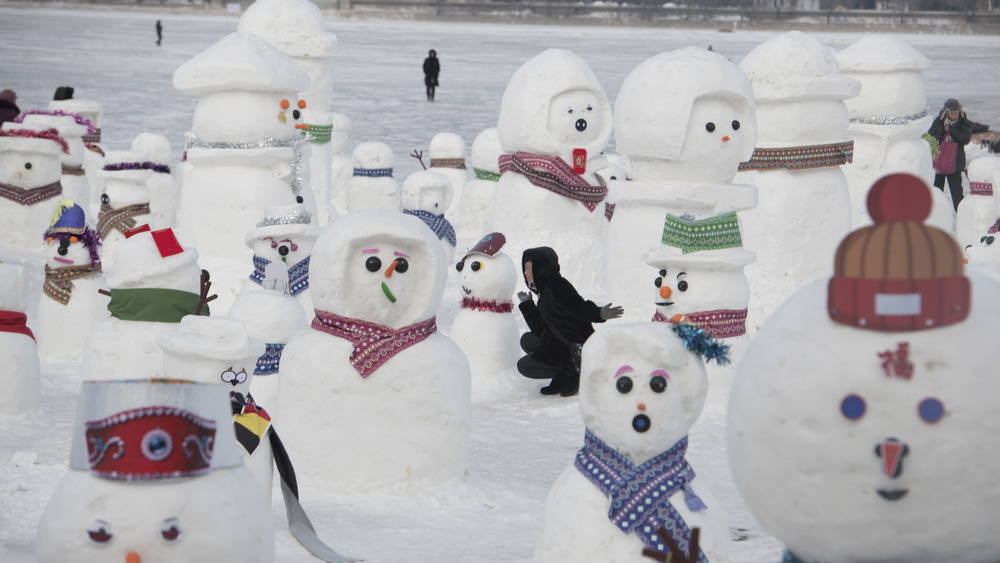The History Of The Snowman Explained
Building snowmen is a traditional winter pastime that many people associate with family, friends, childhood, hot cocoa, hats with pom-poms, snowball fights, Christmas morning, and all sorts of related, homey holiday experiences. 1969's cartoon short "Frosty the Snowman" helped cement our modern, snowmanly vision of a corn cob pipe, button nose, and two eyes made out of coal, itself based on a 1950 song meant to capitalize on the success of country singer Gene Autry's "Rudolph the Red-Nosed Reindeer," as outlined on Mental Floss. Snowmen, though, and their creation, far predate modern versions like Olaf from Frozen, and have a history far more colorful than the white of snow.
In a common sense way, it's understandable why ancient people would have used snow to craft a human figure, or even just play with (if they weren't trying to avoid freezing to death, that is). After all, cave paintings, tribal figurines, and hand-hewn statues all depict the human form, though admittedly, snow is far more temporary than wood or stone. Even the Biblical origin story of humanity portrays God sculpting the first human figure, Adam, from earthly material. In reality, there's no way to know if a human trudging across the Bering Land Bridge from Russia to Alaska stopped for a few minutes to pile up some fresh powder and say, "Look, it's Uncle Carl!" Beyond such speculation, however, there is a very traceable, and even surprisingly anti-Semitic, history behind building snowmen.
A tool of anti-Semitism and political satire
As Atlas Obscura tells us, the first documented snowman comes a 1380 manuscript called the Book of Hours, found in the Koninkijke Bibliotheek in The Hague, Netherlands. In it, there is a somewhat disturbing illustration of a snowman being charred by fire. The snowman conforms to comical, and mocking, depictions of Jewish people at the time, featuring a floppy hat and a sad face with a big, sloping nose. The snowman is built in the typical "ball" method, stacked on top of each other. Writing off to the side substantiates its "blame the Jews" purpose, as it announces the crucifixion of Jesus. Some historians think that this was merely comedy used to deal with the 1400s' horrors of the Black Death.
Snowmen also played a similarly subversive, even politically motivated part in 1511 during the "Winter of Death," as Reader's Digest tells us. To keep people's spirits up, the government of Brussels organized a snow festival for its citizens. The disgruntled masses used the opportunity to craft a "public art installation" of 100 pornographic snowmen mocking prominent government and church officials, in an event now known as the Miracle of 1511. It helps that snow was an abundant, completely free material, and didn't require immense skill to fashion into balls. On the other hand, Michelangelo's deft, skilled hands once crafted what was called a stunningly beautiful snowman in 1484, per All That's Interesting, on commission from a nobleman named Piero the Unfortunate.
Art to suit any wintry role and shape
Eventually, snowmen worked their way into Christmas lore via Prince Albert in Victorian England, because of his enjoyment of typically German holiday iconography and activities, including ice-skating and horse-pulled sleighs. In the end, as Fatherly outlines, we get the media-driven, inviting, friendly version of snowmen such as Frosty. In addition, we get traditions like Zurich Switzerland's Sechseläuten festival, where a snowman called a Böögg gets detonated on the third Monday of April to honor the coming of spring. Non-Western countries such as Japan have jumped on board the snowman fun, too, with a now-30-year-old festival in Sapporo, Hokkaido, where an art display of 10,000+ mini snowmen are built every winter, per Go World Travel.
There are numerous other examples of snowmen used in various artistic and political roles in world history, such as when Dutch settlers in Fort Schenectady in 1690 tried to use snowmen like scarecrows to deter Native American attackers, or when Hans Christian Andersen ("The Ugly Duckling," "The Emperor's New Clothes," "The Little Mermaid") used his 1861 story "The Snowman" to talk about his desire for Harald Scharff, a ballet dancer at Copenhagen's Royal Theatre. In it, the "stove-sick" snowman falls in love with a stove, even though its heat would destroy him.
Maybe this is part of not only snowmen's tangled history, but their ongoing appeal: They can be fashioned into anything, by anyone, and serve their role until they melt away, transient and forgotten.


